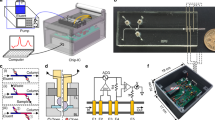Abstract.
Conductivity detection is one of the most often employed means of detection in isotachophoresis. In microanalytical devices, thin-film platinum electrodes can be used for conductivity detection and for other electrochemical methods of detection. The design and the performance of different electrode geometries for on-column contact conductivity detection with thin-film platinum electrodes integrated on an isotachophoresis PMMA-microchip is described. Three different electrode geometries for direct conductivity detection were used for the investigation of isotachophoretic separations. The influence of the width of the electrodes and their positioning relative to the separation channel was investigated. The performance of the different detectors is compared for the analysis of organic carboxylic acid anions.
Similar content being viewed by others
Author information
Authors and Affiliations
Additional information
Electronic Publication
Rights and permissions
About this article
Cite this article
Graß, B., Siepe, D., Neyer, A. et al. Comparison of different conductivity detector geometries on an isotachophoresis PMMA-microchip. Fresenius J Anal Chem 371, 228–233 (2001). https://doi.org/10.1007/s002160100965
Received:
Revised:
Accepted:
Published:
Issue Date:
DOI: https://doi.org/10.1007/s002160100965




